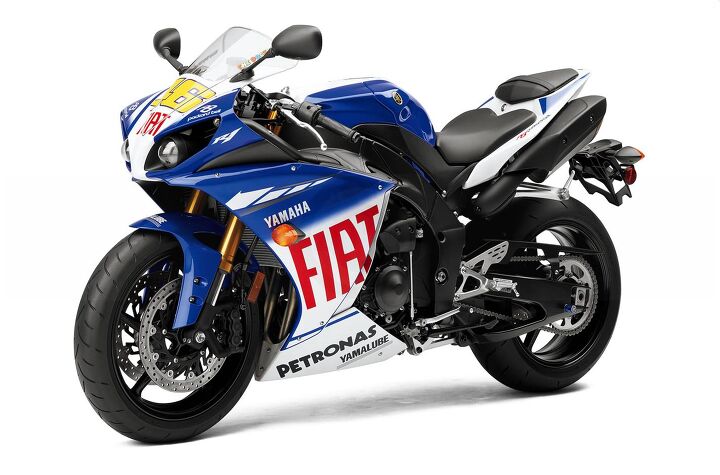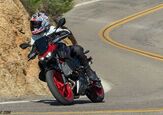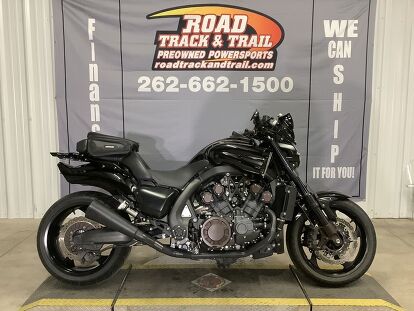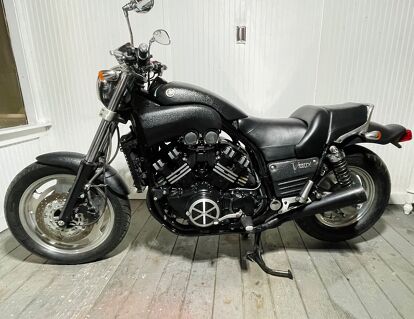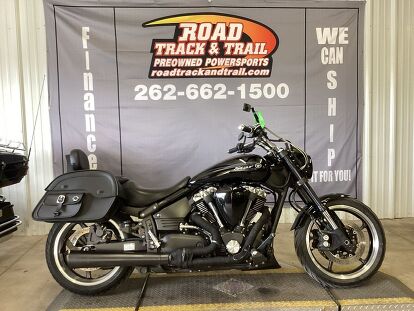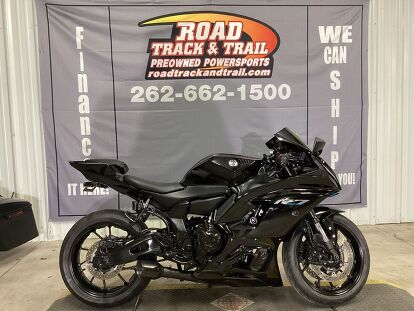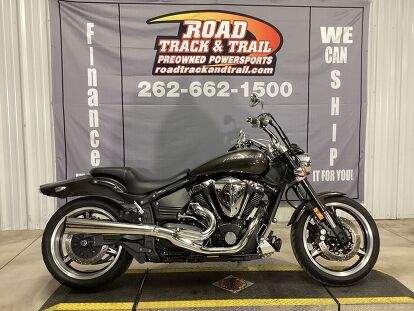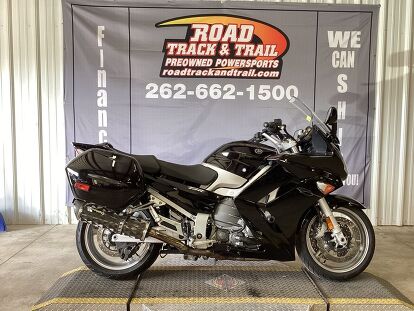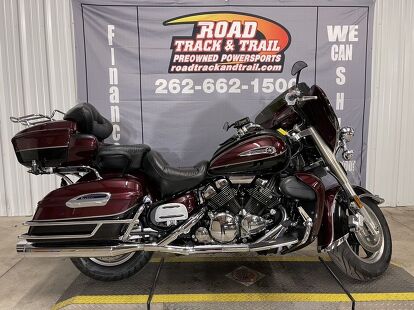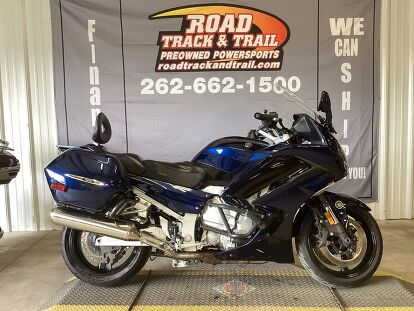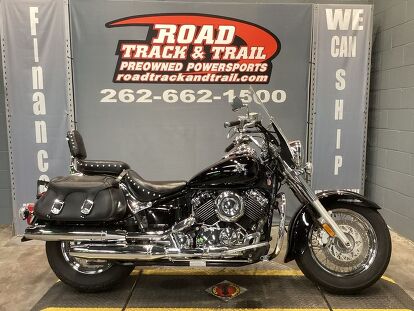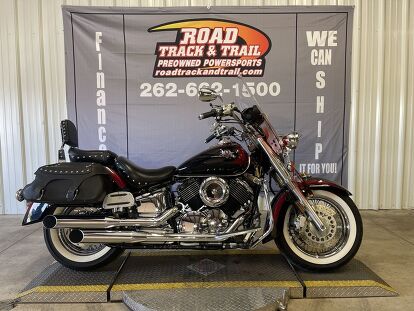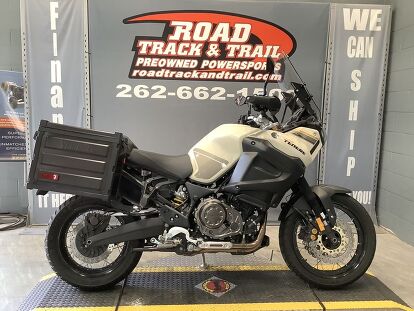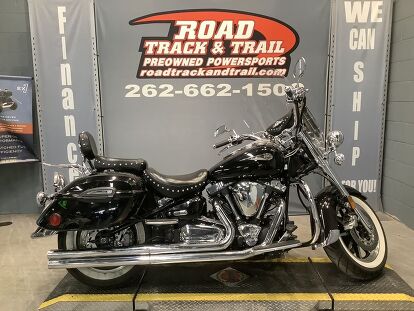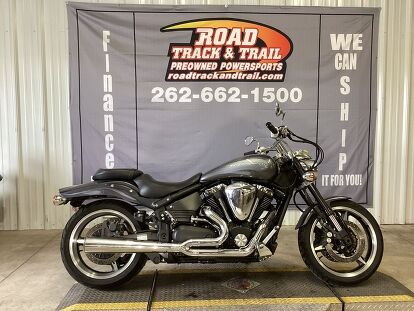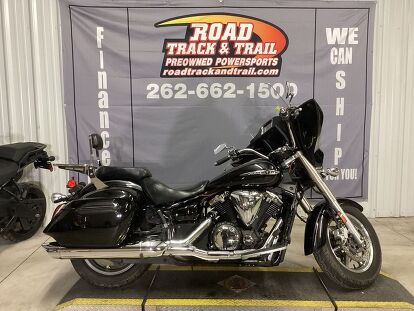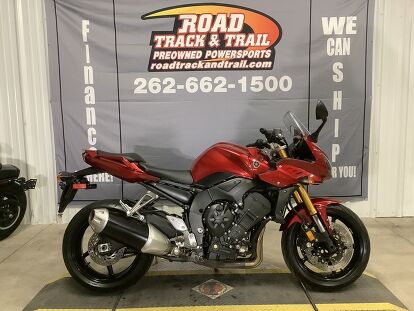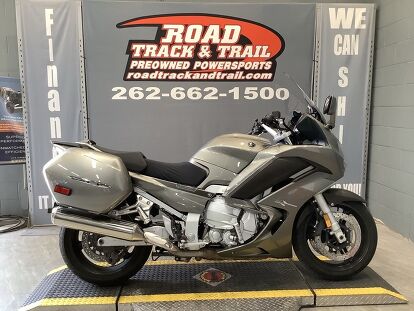Product description
Introducing the 2010 R1 Yamaha's technical "Tour de Force."
The R1 has been designed to be the "Ultimate Cornering Master" of the open super sport class and one of the keys to incredible handling lies partly in the chassis but equally as important, in its ability to put useable power to the ground. This revolutionary cross-plane crank R1 delivers as much power as the rider wants, exactly when the rider wants it by a simple twist of the right wrist; leaving the rider feeling like they are directly connected to the rear wheel of the new R1.
Engine SpecificationsEngine: Liquid-cooled, DOHC, 16-valve, in-line four
Displacement: 998cc
Bore and Stroke: 78 x 52.2mm
Compression Ratio: 12.7:1
Maximum Torque: 11.7kg-m (84.6ft-lb) @ 10,000 rpm
Fuel Delivery: Mikuni 45mm throttle body FI
Estimated Fuel Consumption*: 14kpl / 40mpg (Imp.)
Lubrication: Wet sump
Ignition / Starting: Digital TCI / Electric
Transmission: 6-speed
Chassis SpecificationsSuspension (Front): Fully adj. 43 inverted fork
Suspension (Rear): Fully adj. Link Monocross
Brakes (Front): Dual 310mm discs
Brakes (Rear): 220mm disc
Tires (Front): 120/70ZR17
Tires (Rear): 190/55ZR17
DimensionsLength: 2,070mm (81.5")
Width: 715mm (30.3")
Height: 1,130mm (44.5")
Wheelbase: 1,415mm (55.7")
Rake / Trail: 24 / 102mm
Ground Clearance: 135mm (5.3")
Seat Height: 835mm (32.9")
Fuel Capacity: 18 litres (4 Imp. gal.)
Wet Weight: 206kg (453.2lb)
Colour(s): Yamaha Blue. Metallic Black, Bluish White, Rossi Special Edition
Engine FeaturesUltra-lightweight, compact, 998cc, DOHC, 16-valve, liquid-cooled, 40 degree inclined, in-line four-cylinder engine with "crossplane" style crankshaft.
The key components of this cutting edge engine design are the "crossplane" crankshaft and an uneven firing order. Both of these features are used on Yamaha's championship winning M1 MotoGP racer. Please note this is not a "big bang" engine. The R1 departs from the norm for in-line 4 cylinder engines and the 180 degree alignment of the crank pins (where the connecting rods attach to the crankshaft), and locates the center two rods at a 90 degree plane from the outer cylinders. This means instead of the crank pins aligned on the same plane (a straight line drawn through the center of the crankshaft), they align on 2 planes in the form of a cross ... or "crossplane". Working in conjunction with the crossplane crank is an uneven firing order. A traditional in-line 4 cylinder's firing order is normally 1,2,4,3 with a 180 degree interval. This R1 engine fires 1,3,2,4 cylinders and the firing intervals are uneven at 270 / 180/ 90 /180 degrees. What all this means to the rider is the most linear torque possible and amazing throttle control. This engine design allows a whole new level of rider - machine communication. One of the most important benefits is the outstanding cornering performance that increased engine control allows.
The engineering goal for the R1 is controllability not just an increase in horsepower. If that was the case, we could have simply increased the power output of the existing engine design resulting in a peaky, hard to use power band.
The 4-valve cylinder head design features a compact combustion chamber that utilizes lightweight, trick, titanium valves on the intake side. The 4-valve design maximizes breathing efficiency and overall engine performance. This design also achieves cleaner emissions too.
The titanium intake valves are 31mm in diameter while the steel exhaust valves are 25mm in diameter. Lightweight yet super strong VX alloy valve springs control valve movement.
Steep valve angles, 11.5 degrees on the intake side and 12.5 degrees on the exhaust produce a compact combustion chamber.
The lightweight titanium intake valves reduce the reciprocating weight of the intake valves allowing for higher rpms without the concern of valve float. The use of lightweight "Ti" valves has allowed the engineers at Yamaha to use a 4-valve format. In the past, the use of 5 smaller valves allowed a higher rpm limit since each of the "smaller" valves was relatively light. The use of light weight titanium now means the engineers no longer have to use the 5-valve design to achieve the same high rpms.
Combustion chambers have been optimized for maximum engine performance. The compression ratio is 12.7:1.
Compact automatic cam chain tensioner reduces both maintenance and engine mechanical noise.
Short skirt, forged aluminium pistons offer light weight, fast throttle response and great reliability.
Crossplane crankshaft features 36mm journals for increased strength, while the inertial moment of the crank has been increased by 20% versus the last generation R1.
Connecting rods are carburized and use a nut less design. The lower end "cap" of the rod is made from the same piece of material as the upper portion and is cracked away in a process known as "fracture splitting". This process aids true big end roundness and greater precision in con rod dimensions.
Ceramic composite cylinder "bores" are a "liner less" design with the ceramic coating applied directly to the aluminium block to ensure uniform heat dissipation for consistent power delivery, reduced oil consumption, reduced friction and reduced weight.
Closed deck cylinder design allows the cylinders to be spaced more closely together, allowing a narrower engine.
The cylinder block is a stand-alone piece (not integrated into the upper crank case). The benefit is reduced weight and a less tall engine which lowers the centre of gravity.
A "coupling force balancer" is used to quell engine vibration.
Compact ACM (alternator) is mounted directly to the crankshaft. The compact ACM uses rare earth magnets which produce more power for a given size than conventional magnets, therefore reducing size and weight.
All Mikuni fuel injection system features twin injectors (one set of primary & one set of secondary injectors). This type of twin injector system is also used on our M1 MotoGP race bike and the R6. One set of injectors (primary) are located in the 45mm throttle bodies while the secondary injectors are located in the air box very near the computer controlled intake funnels. The primary injectors utilize 12 spray holes to maximize the fuel atomization process. The secondary injectors, located inside the air box, begin to function at mid rpms onwards to supply more fuel as required. This system is lighter and simpler than the sub motor driven secondary valve type FI system, which is no longer utilized due to Yamaha's chip controlled throttle ( YCC-T).
The F.I. system features separate dual track TPS (throttle position sensor) and APS (accelerator position sensor) sensors
An oxygen sensor is fitted into the exhaust collector making this a "closed loop" type FI system, which feeds back info to the ECU so adjustments can be constantly made to the fuel-air mixture for improved performance and reduced emissions.
The benefits of fuel injection include excellent throttle response, great fuel economy, reduced emissions, stable idling and no choke to fuss with during start up.
The fuel injection's lightweight Electronic Control Unit (ECU) utilizes a powerful 32-bit processor for fast control of the injection process. The compact design also reduces weight.
YCC-I or Yamaha's Chip Controlled Intake means the intake funnels / stacks vary in length (2 positions) depending on engine rpm. An electronic servo motor varies the funnel length from the tall position at low to mid rpms to the shorter setting for improved high rpm power. The transition rpm between the 2 lengths is approx. 9,400 rpms. The revolutionary YCC-I provides the best of both worlds solid low rpm torque and power combined with an amazing high rpm rush. It takes only 0.3 of a second for the funnels to move from the tall to the short position.
Yamaha's exclusive YCC-I electric-control servo motor-driven variable intake funnel system is a world's 1st on a production motorcycle and works in conjunction with Yamaha's fly-by-wire technology and FI Systems.
Yamaha Chip Control Throttle (YCC-T) electronically controls the throttle valves for outstanding response and improved controllability at all rpms. The YCC-T is used to provide even more control of the intake air volume for smoother torque character. Similar to the R6 design, the YCC-T features 3 - ECU's inside the main ECU to control ignition, fuel injection and the YCC-T. This special ECU is capable of responding to changes at a speed of 1000th of a second.
The rider can "mechanically close" the throttles by simply closing the throttle twist grip.
Long life Iridium twin electrode longer reach NGK LMAR9EJ spark plugs are used.
Compact close-ratio 6-speed transmission features optimized gear ratios for maximum performance. The "stacked" 3-axis gearbox / clutch design stacks input/output shafts to create a low center of gravity and keeps overall engine size shorter front to back. As a result, the stacked design gives the engineers the freedom to place the engine in the "sweet spot" of the frame for optimum weight balance for awesome handling.
The slipper or back limiter clutch assembly reduces rear wheel hop when making hard down shifts when under hard braking. Key benefit is reduced lap times and smoother control when riding aggressively during a race or track day.
A multi plate clutch is used, utilizing coil springs and paper based fibre plates.
"Ram Air" system "force feeds" outside air via dual ducts located beside the projector headlights into the intake system. As speed increases the air velocity in the system increases and pressurizes the air box. This "force fed" air helps the engine develop maximum power.
Computer optimized large capacity air box maximizes performance. A viscous type, high flow air filter is utilized.
4 into 2 into 1 into 2 titanium exhaust system maximizes power output, reduces weight and improves aerodynamics. The dual under seat mufflers provide an aggressive sound as well as a great styling highlight. This system contains a 3-way honeycomb catalyser and an oxygen sensor. The catalytic converters reduces harmful CO and HC exhaust emissions while the oxygen sensor provides feedback to the ECU to maintain optimum fuel/air mixture at all times.
Dual shorty, large diameter triangle shaped mufflers are a "single expansion" type that create a throaty exhaust note and help emphasize engine character. The exhaust note is much different than on previous R1 models due to the crossplane crank and uneven firing order it sounds very similar to Yamaha's M1 MotoGP race bike.
Compact, high-efficiency curved radiator features dual ring-type fans for maximum cooling efficiency. This curved rad and twin fan design produces more airflow than conventional flat designs to maintain optimum engine temperatures for consistent power output.
Large liquid-cooled oil cooler maintains stable lubricant temperatures for extended engine life. Convenient cartridge style spin-off oil filter.
Convenient clutch cover sight glass ensures easy oil level inspection.
High performance direct ignition coils (ignition coil is built into the spark plug cap) reduce weight while iridium spark plugs and high-output magneto deliver increased spark energy.
Yamaha D-Mode variable throttle control enables the rider to adjust the performance characteristics of the engine based on riding preferences or conditions. Standard mode emphasises the very linear throttle and torque feel of the engine. The A mode allows the rider to enjoy sportier engine performance in the low to mid rpm mode. While the B Mode reduces the power response for riding situations that require softer power characteristics. The switch mechanism is located on the RHS switch gear.
Chassis/Suspension FeaturesAluminium Deltabox frame has been designed to offer an optimized rigidity balance to maximize handling performance. This frame is very rigid or stiff at the head pipe, engine mounts and swingarm pivot point. In other areas, material has been carefully removed to allow "tuned flex". Finished in black, this frame boasts a compact 1415mm (55.7") wheelbase. The swingarm pivot location has been optimized to minimize the chain tension effect under hard acceleration, providing more stable handling. The engine is a fully stressed chassis member to maximize handling. Stability, a key to great handling, is unsurpassed while the ability to hold a line under hard acceleration is excellent. This frame features a mix of gravity cast (head stock & front engine mounts & swingarm pivot area), CF (controlled filling) die cast (outer tank rails) and aluminium panels (inner tank rails). Each of these aluminium parts has different flex characteristics in order to provide the rigidity balance the engineers desired.
The engine mounting location in the aluminium frame is different than previous R1 models. The engine incline (9 degrees) and location (12mm forward) has been changed to improve the weight balance, front to rear weight ratio and the centre of gravity.
Detachable magnesium CF die cast rear subframe reduces weight. The detachable design allows rear shock access and is less costly to repair if accidentally damaged.
Extra-long, lightweight aluminium "truss-type" swingarm provides great torsional rigidity for class leading handling, agility and manoeuvrability. This new lighter swingarm is made up of cast aluminium and CF die cast parts. The distance between the swingarm pivot and the rear axle has been optimized (597 mm) for excellent "turn-in" abilities and rear wheel traction.
This Deltabox chassis offers an incredible 56 degree lean angle.
Fully adjustable 43mm inverted fork features independent left and right damping system. The compression damping is adjusted via the left fork leg, while rebound damping is adjusted on the right fork leg. This system simplifies the flow of oil through the fork and minimizes oil cavitation (aeration of the oil) for more stable suspension performance. Front wheel travel is 120mm (4.7"). The thickness of the inner tube and the shape of the outer tube have been optimized. The adjustable design allows the rider to tailor suspension settings to match rider weight and road /track conditions to maximize handling and suspension performance.
Bottom link Motocross rear suspension utilizes a fully adjustable piggyback-style rear shock. The bottom link design lowers the centre of gravity for excellent handling. This shock features 2-way (hi speed & low speed) compression adjustment plus rebound and spring preload adjustability too. This is a rising rate or progressive system. The adjustable design allows the rider to tailor suspension settings to match rider weight and road /track conditions to maximize handling and suspension performance. Rear wheel travel is 120mm (4.7").
Radial mount 6-piston calipers squeeze new fully floating 310mm dual front rotors. The result is incredible braking performance with excellent control and lever feedback. The rotors and carriers feature a new design.
Brembo radial pump master cylinder with 16mm piston is a direct GP race innovation. The lever is adjustable for various hand sizes.
Single piston (aluminium) slide-type Nissin rear caliper squeezes a lightweight 220mm rotor.
Rugged yet lightweight 5-spoke mag wheels front and rear. The wheels utilize hollow "spokes" to reduce unsprung weight for superior handling. Front rim size is a MT3.50 x 17 while the rear is MT6.00 x17.
Premium Dunlop D210 sport spec radial tires front and rear.
18 litre fuel tank provides excellent knee grip for hard braking and great rider manoeuvrability. The elongated shape helps to centralize mass and reduces the variance in riding feel as the fuel load (weight) changes.
Additional FeaturesAdjustable footrests can be raised 15mm upward and 3mm backward if desired.
Immobilizer ignition system is designed to reduce the possibility of "ride away" theft. This system must recognize the "coded ignition key" in order for the unit to start. If the immobilizer ignition does not recognize the key (or a thief's screwdriver or other type of "jimmy tool") the bike will not start even if the ignition is turned or forced into the on position. If the system does not recognize the coded chip in the ignition key, it will not allow the ignition system, fuel pump or starter motor to function.
Race inspired fairing improves both aerodynamics and style. The fairing features a slant nose front profile for aerodynamic streamlining, with engine revealing side cut outs.
Windshield features a "screw less" design for a cleaner, more trick appearance.
Slim design rear tail section.
Race inspired lightweight instrumentation includes an analog tach plus digital speedo, dual tripmeters, clock, coolant temperature and fuel trip meter. This console also features adjustable back lighting, adjustable shift light and a low fuel warning light. Other key features include a gear position indicator, accelerator opening angle indicator, engine mode indicator integrated stop watch, lap timer with split time mode and an air intake temperature display. The lap timer is controlled by the starter switch button for added convenience and ease of use
Dual 55-watt halogen projector headlights are compact and thereby allow the ram air intake ducts to be integrated into the framework of the headlight assembly. The lights not only cast a very bright beam of light, but also add a unique styling touch.
LED taillight reduces weight and power consumption while providing a brilliant eye catching light. The lens is white while the LEDs are red.
The seating position offers a very sporty yet comfortable riding position.
Lightweight forged footpegs for high strength.
Extensive use of hollow bolts and lightweight fasteners help trim overall weight.
Heavy-duty 50 series "O" ring drive chain.
Low maintenance, lightweight, sealed battery.
Convenient fold out under seat bungee cord straps.




